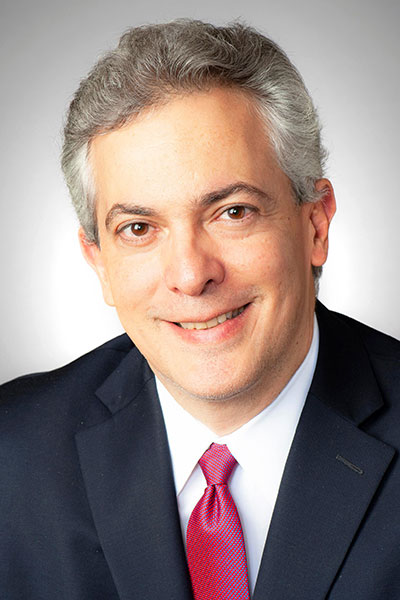Asthma expert to share career and life experiences upon receiving recognition for major research contributions to the field
“Even though it was long ago, I still remember that sensation of asphyxiation — the fish out of water, just gasping for air,” recalled Juan C. Celedón, MD, DrPH, ATSF.

That was in Colombia during the late 1960s, when Dr. Celedón was a young boy, and his mother would rush him to the pediatrician’s office for nebulizer treatments. On several occasions, his breathing problems led to hospitalization.
“In those days, the terminology was not known, but probably I had what we now call transient wheeze,” said Dr. Celedón, division chief of pulmonary medicine at UPMC Children’s Hospital of Pittsburgh and the Niels K. Jerne Professor of Pediatrics and Medicine, University of Pittsburgh.
Dr. Celedón will reflect on how lessons from his life impacted his research and professional career as he delivers the 2025 J. Burns Amberson Lecture, “A Nosy Look Into Asthma Disparities,” during the Respiratory Health Awards Ceremony from 4:30 to 5:30 p.m. PT, Sunday, May 18, in the Moscone Center, Esplanade Ballroom (South Building, Upper Mezzanine).
Dr. Celedón was one of the fortunate ones. As his airways grew, he stopped having problems breathing; but that same child, who gasped for survival, would return in his professional life to focus on airways and health.
He finished medical school in Colombia, then moved to the United States for an internship at Lincoln Hospital in the Bronx and a residency at Beth Israel Medical Center in Manhattan. He subsequently took a fellowship at Brown University, served in the federal government at the Erie VA Medical Center in Erie, Pennsylvania, completed a research fellowship at Brigham and Women’s Hospital, and earned his Doctor of Public Health degree at the Harvard T.H. Chan School of Public Health.
His experiences and educational journey helped him become a renowned physician-researcher in respiratory disorders, particularly asthma. In his publications and work, he interrogates the genomics and epidemiology of airway disease and constantly poses larger questions about the structural determinants of health that shape a patient’s or a community’s ability to breathe.
In his research, Dr. Celedón has turned to large themes, such as why Puerto Ricans are disproportionately affected by asthma. Early in his career, he established studies of asthma in Puerto Rican children and families. These studies have continued for 20 years and are now in phase 3, continuing to collect data from some of the original youth participants who are now ages 21 to 29.
Having spent decades publishing studies on omics and environmental risk factors for asthma in ethnic and geographical communities, Dr. Celedón’s latest work has focused on two key questions: how environmental factors influence biology and the function of genes that may predispose to or protect against asthma, and how asthma subtypes might be similar or different between various groups of people, either by ethnicity, geography, or other factors.
In recent research, Dr. Celedón and his colleagues collected nasal samples from children, adolescents, and young adults with and without asthma to examine the methylation and transcription of certain genes and to identify signals correlated with specific phenotypes or endotypes of asthma. With these samples and information, they identified subtypes of asthma, endotypes traditionally known as T2-high or T2-low, but more recently further sub-typed into T17-high and T2-low/T17-low. They also showed that, contrary to prior accepted belief, in this sample population of patients predominantly of Puerto Rican or African American descent, T2-high is less common than the other two endotypes.
This is significant because current treatments for asthma are designed specifically for T2-high endotypes, not the T17-high or T2-low/T17-low endotypes.
“More work needs to be done, but our hope is that you can use these nasal tests and enroll kids into clinical trials testing based on their specific type of asthma instead of having all types of asthma lumped together,” Dr. Celedón said.
He added that identifying specific endotypes and developing personalized medicine based on this knowledge has been a reality in cancer therapy that can now be further explored in research and clinical trials for asthma.
Dr. Celedón explained that interesting questions remain about the risk factors, permanence, or mutability of asthma endotypes.
“It may be that sometimes these endotypes overlap, and you have more than one endotype. Do treatments affect and can they switch endotypes? We don’t know yet,” he said.
Dr. Celedón noted that our increased awareness of differing endotypes also opens possibilities for researchers to ask new questions by returning to sample populations collected in bio databanks. It also brings renewed attention to the importance of ensuring a vast and diverse population sample.
“There may be genetic mutations that are more important in one group than others. We cannot lose sight of that. And this push to exclude or reduce inclusion will be detrimental to everybody because the reality is we learn a lot from studying high-risk groups,” said Dr. Celedón.
In addition to his research work, Dr. Celedón has been active in ATS leadership, serving as president during one of the most unpredictable times: the COVID-19 pandemic in 2020–2021.
Amberson Lecture
4:30 to 5:30 p.m. PT, Sunday, May 18
Moscone Center, Esplanade Ballroom (South Building, Upper Mezzanine)
The lecture is part of the 2025 Respiratory Health Awards Ceremony, and entry is open to all conference attendees.
Looking back, Dr. Celedón says he continues to draw inspiration from how ATS members and the field of respiratory health faced the crisis with collaborative and empathetic responses.
However, he fears that the ability of the health community and government to respond is being weakened by funding cuts to key agencies and research projects, which may leave these communities unprepared for the next global pandemic.
“Federal agencies, such as the NIH, have made a profound difference in the lives of Americans and a lot of people around the world. People may not appreciate that, but there are some very impressive stats. In 1950, mortality from respiratory distress syndrome in newborns was greater than 50%. Today, it is less than 2% because of discoveries funded by NIH in the 1950s,” Dr. Celedón said. “And even if you are not interested in the humanitarian impact of NIH-funded research, it’s a good financial investment. Every dollar invested in NIH generates $2.46 in direct returns. The economic impact for states — whether red or blue — is enormous.”
The Amberson Lecture is named for James Burns Amberson, an international authority on chest disease and tuberculosis. This lecture recognizes major international lifetime contributions to clinical or basic research that have advanced the fundamental understanding of basic, translational, or clinical approaches to respiratory disease, critical illness, or sleep disorders.
Extend Your Learning Beyond San Francisco with ATS 2025 Conference Highlights

With so many valuable educational opportunities offered during the ATS 2025 International Conference, attendees are often forced to decide which sessions to prioritize. That’s why the Society is offering three ATS 2025 Conference Highlights packages for those unable to attend ATS 2025 San Francisco or attendees interested in continuing their education after the conference. Check out the packages and pick the one that’s right for you. Learn at your own pace, whenever and wherever you are!

